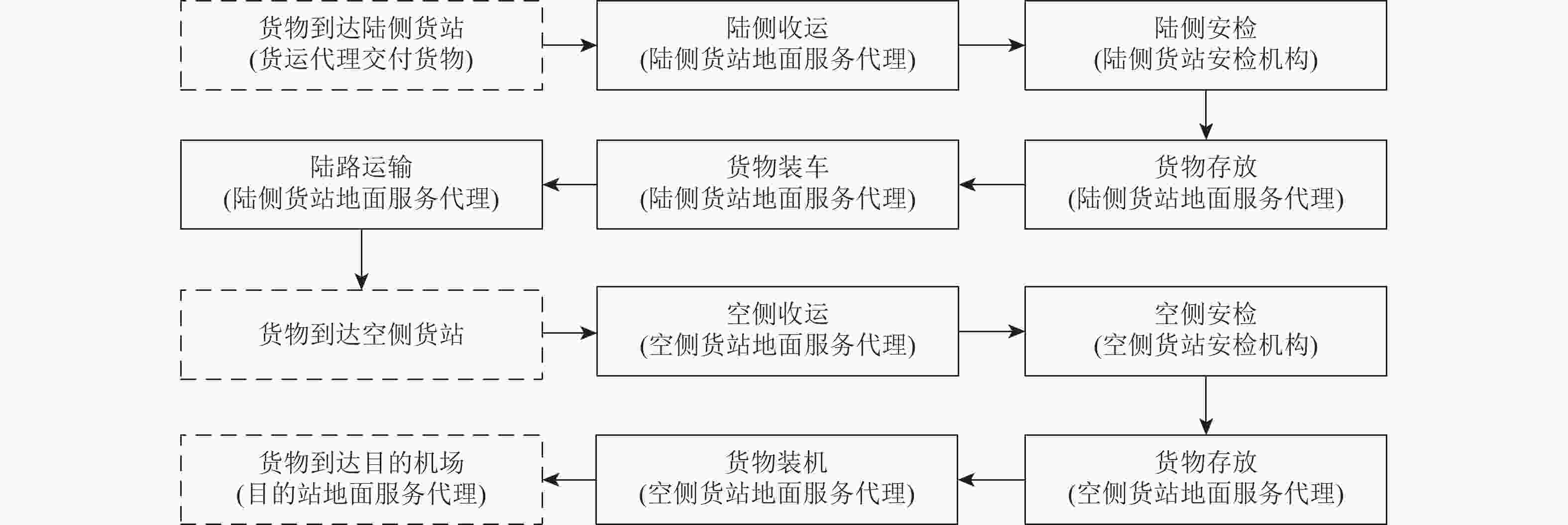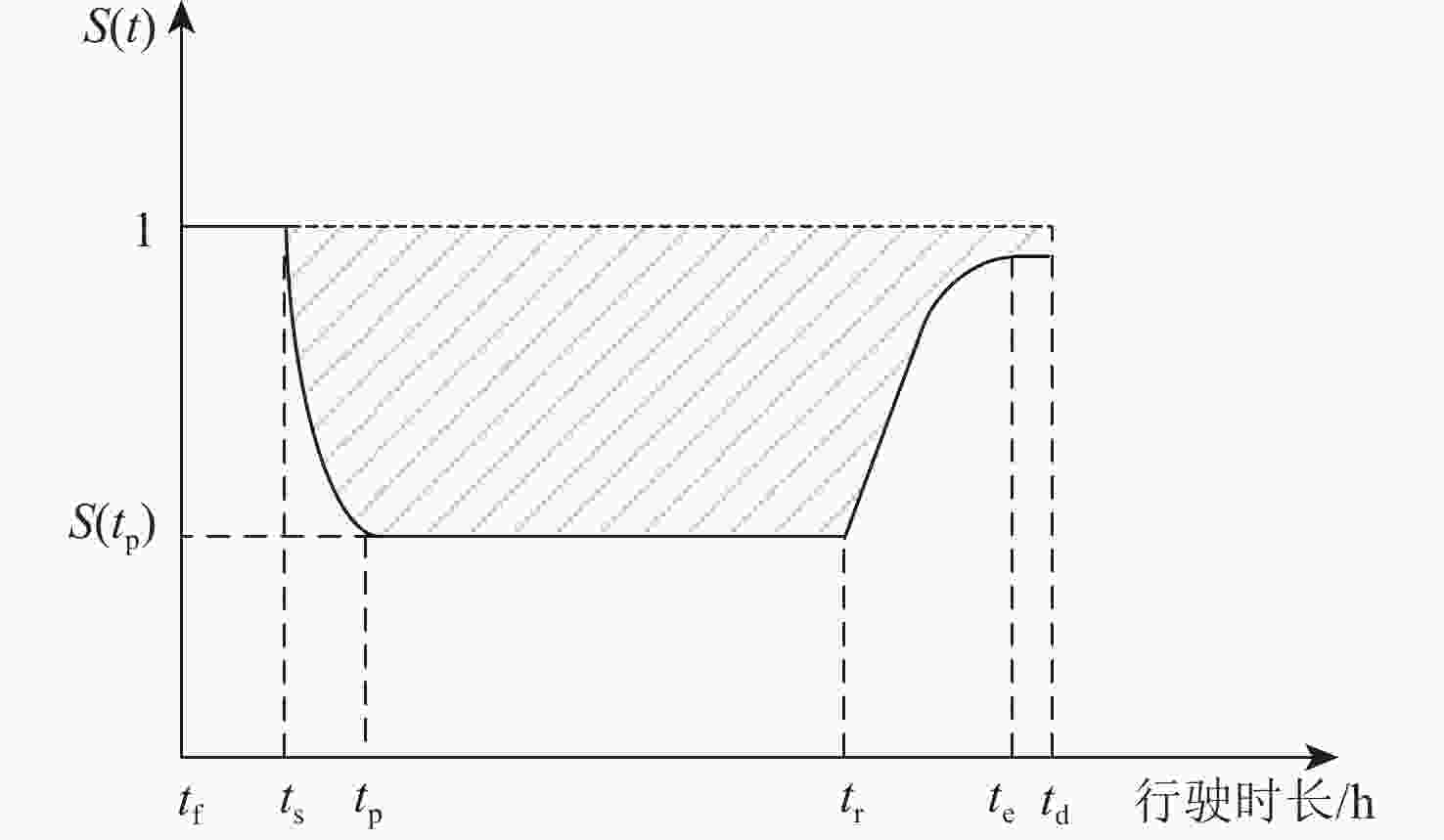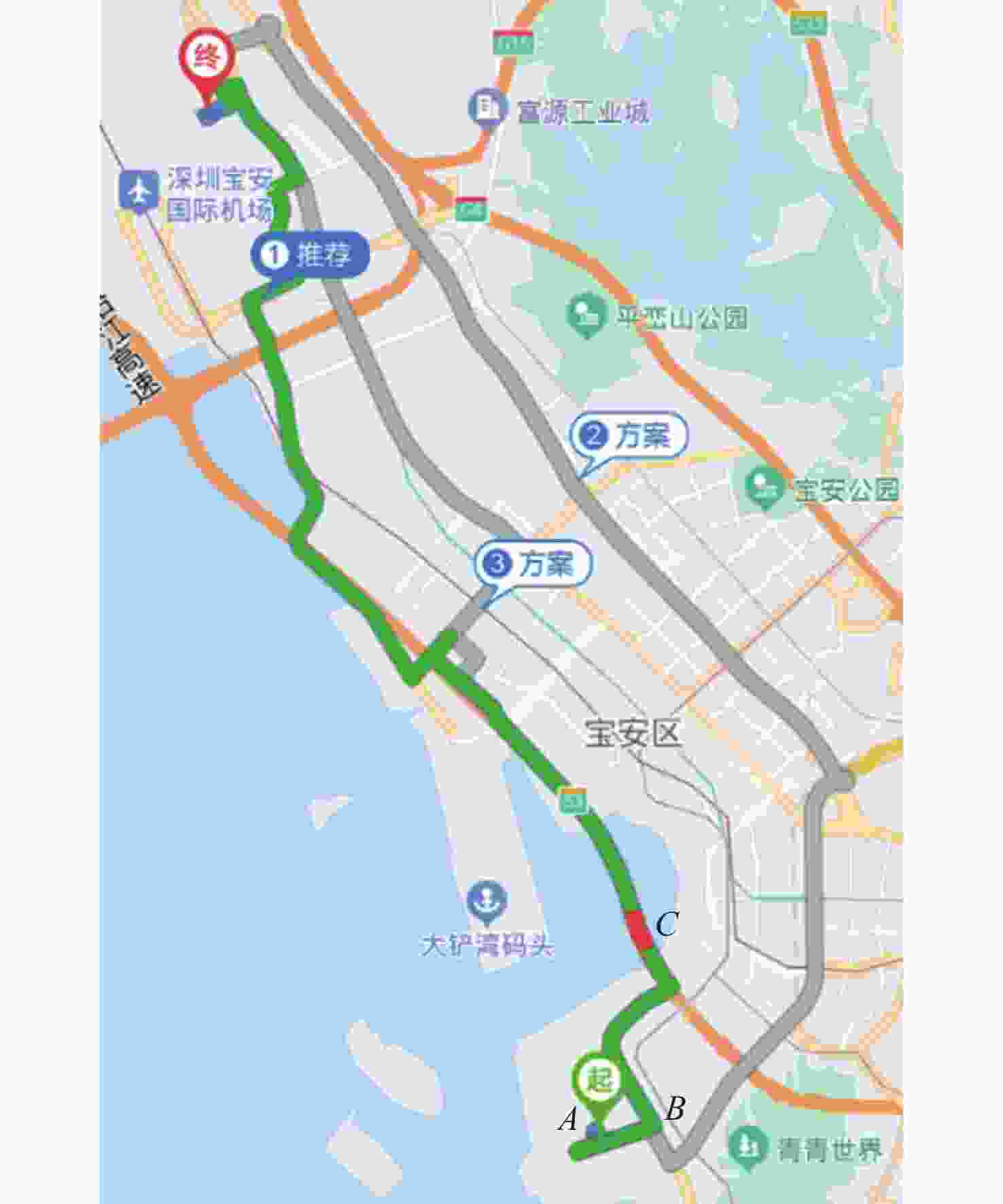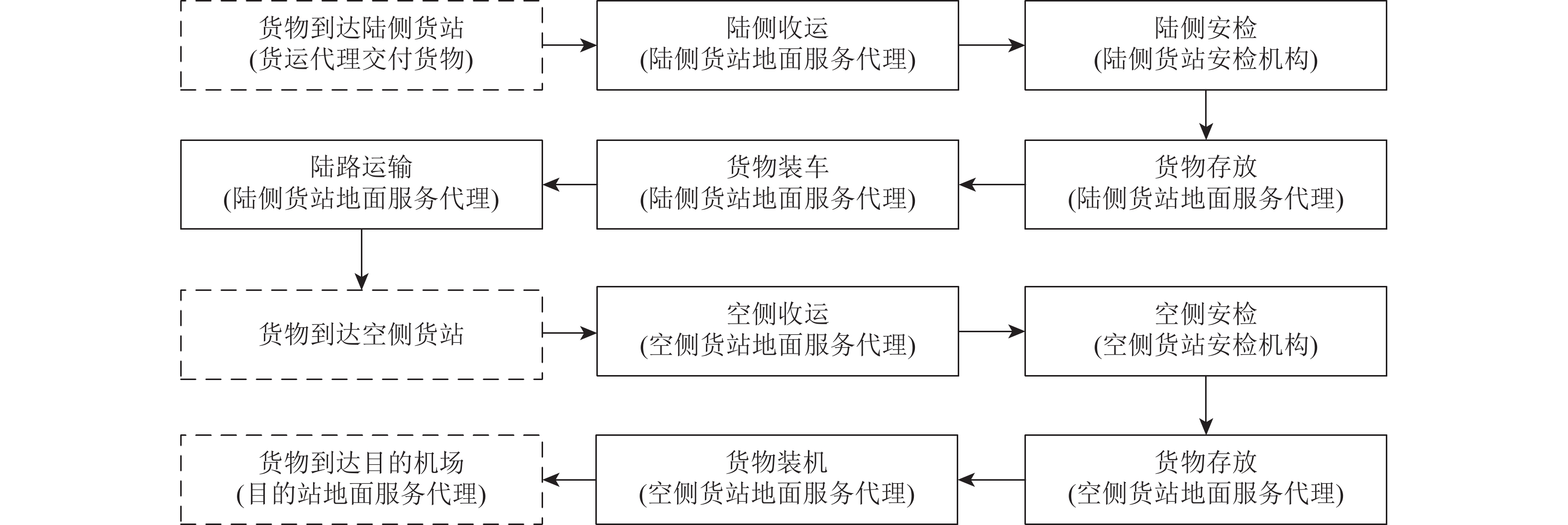-
摘要:
为提升航空货运安保供应链的弹性水平,针对陆路运输环节偏移指定路线的扰动情形,根据弹性三角形理论进行弹性测度。在恢复阶段,为寻求最优弹性,以弹性最大化为目标,求解恢复水平、设备数量、恢复时间约束下的最优恢复策略,即确定在空侧货站需采取的安检方式、各安检方式的货物检查量和使用的安检设备台数。以深圳宝安国际机场为例,选取路线偏移作为扰动事件进行分析。结果表明:随着货物总量或扰动时长增大,航空货运安保供应链弹性降低;安检速率、安检设备数量、违禁品检出率决定分配货物检查量时各安检方式的优先性;降低扰动市场、增大安全速率、提高违禁品检出率可提高航空货运安保供应链弹性。
Abstract:To enhance the resilience level of the air cargo security supply chain, elastic measurement is conducted based on the theory of elastic triangles to address the disturbance caused by the deviation of designated routes in the land transportation process. In the recovery phase, in order to seek the optimal elasticity, with the goal of maximizing elasticity, the optimal recovery strategy is solved under the constraints of recovery level, equipment quantity, and recovery time, that is, to determine the security inspection methods to be adopted at the airside cargo terminal, the cargo inspection volume of each security inspection method, and the number of security inspection equipment used. Taking Shenzhen Bao'an International Airport as an example, route deviation is selected as the disturbance event for analysis. The results indicate that as the total amount of goods or disturbance duration increases, the elasticity of the air cargo security supply chain decreases; The priority of each security check method is determined by the speed of security checks, the number of security check equipment, and the detection rate of prohibited items when allocating the amount of goods for inspection; Reducing market disruptions, increasing safety rates, and improving prohibited item detection rates can enhance the resilience of the air cargo security supply chain.
-
Key words:
- air cargo /
- secure supply chain /
- resilience /
- recovery strategy /
- short-distance lightering
-
表 1 路线数据
Table 1. Route data
路线 停靠点数量 事故易发路段数量 路线长度/km 拥堵长度/km 路线1 14 0 22 1.21 路线2 16 1 22 1.36 路线3 9 2 26 1.68 表 2 路线风险性评估指标标准化数据
Table 2. Standardized data of route risk assessment indicators
路线 停靠点数量 事故易发路段数量 路线长度/km 拥堵长度/km 路线1 0.61 0 0.54 0.49 路线2 0.69 0.45 0.64 0.55 路线3 0.39 0.90 0.64 0.68 最优 0.69 0.90 0.64 0.68 最劣 0.39 0 0.54 0.49 表 3 路线风险性
Table 3. Routes risk
路线 $ D_m^ + $ $ D_m^ - $ $ {{C}}_ m $ 风险性次序 路线1 0.46 0.11 0.13 3 路线2 0.23 0.28 0.36 2 路线3 0.15 0.46 0.51 1 表 4 参数设置
Table 4. Parameter settings
类型 参数 取值 时间 ${t_{\mathrm{f}}}$/h 0 ${t_{\text{s}}}$/h 0.2 ${t_{\text{r}}}$/h 1.0 ${t_{\text{d}}}$/h 1.3 tp/h {0.4,0.6,0.8,1.0} 资源 $ {D}_{\text{1}}、{D}_{\text{2}}、{D}_{\text{3}} $ 2、2、2 $ {v}_{1}、{v}_{2}、{v}_{3} $ 80、65、70 $ {P}_{1}、{P}_{2}、{P}_{3} $ 0.5、0.7、0.85 ${S_0}$ 0.9 $ Q $ {20,24,28,32,36} 表 5 最优弹性值和恢复策略
Table 5. Optimal resilience and recovery strategies
条件 最优弹性值 恢复策略 Q=20 Q=24 Q=28 Q=32 Q=36 Q=20 Q=24 Q=28 Q=32 Q=36 ${t_{\text{p}}} = 0.4 $,
3种安检方式均可用0.8978 0.8970 0.8962 0.8955 0.8948 [0,6,14] [0,8,16] [0,10,18] [2,12,18] [4,14,18] $ {t_{\text{p}}} = 0.6 $,
安检方式2、安检方式3可用0.8322 0.8306 0.8291 0.8277 0.8262 [0,6,14] [0,8,16] [0,10,18] [0,14,18] [0,16,20] ${t_{\text{p}}} = 0.8 $,
安检方式3可用0.7905 0.7864 0.7824 0.7783 0.7743 [0,0,20] [0,0,24] [0,0,28] [0,0,32] [0,0,36] ${t_{\text{p}}} = 1.0 $,
安检方式3可用0.7736 0.7685 0.7635 0.7584 0.7534 [0,0,20] [0,0,24] [0,0,28] [0,0,32] [0,0,36] 表 6 增大$ v_i $后的最优弹性值和恢复策略
Table 6. Optimal resilience and recovery strategy after increasing$ v_i $
条件 最优弹性值 恢复策略 原始值 仅v1提升5 仅v2提升5 仅v3提升5 $ v_i $均提升5 原始值 仅v1提升5 仅v2提升5 仅v3提升5 $ v_i $均提升5 $ t_{\text{p}} $=0.4,
3种安检方式均可用0.8948 0.8948 0.8949 0.8951 0.8592 [4,14,18] [4,14,18] [4,14,18] [4,12,20] $ t_{\text{p}} $=0.6,
安检方式1不可用0.8262 0.8262 0.8266 0.8269 0.8271 [0,16,20] [0,16,20] [0,16,20] [0,14,22] $t_{\text{p}} $=0.8,
安检方式1、安检方式2不可用0.7743 0.7743 0.7743 0.7767 0.7767 [0,0,36] [0,0,36] [0,0,36] [0,0,36] [0,0,36] 表 7 增大$ P_i $后的最优弹性值和恢复策略
Table 7. Optimal resilience and recovery strategy after increasing $ P_i $
条件 最优弹性值 恢复策略 原始值 仅P1提升0.1 仅P2提升0.1 仅P3提升0.1 仅P4提升0.1 原始值 仅P1提升0.1 仅P2提升0.1 仅P3提升0.1 仅P4提升0.1 $ t_{\text{p}} $=0.4,
3种安检方式均可用0.8948 0.8954 0.8961 0.8964 0.8979 [4,14,18] [8,10,18] [2,16,18] [2,12,22] [6,12,18] $ t_{\text{p}} $=0.6,
安检方式2、安检方式3可用0.8262 0.8262 0.8288 0.8295 0.8318 [0,16,20] [0,16,20] [0,16,20] [0,14,22] [0,16,20] $ t_{\text{p}} $=0.8,
安检方式3可用0.7743 0.7743 0.7800 [0,0,36] [0,0,36] [0,0,36] $ t_{\text{p}} $=0.8,
安检方式2、安检方式3可用0.7900 0.7942 [0,16,20] [0,16,20] -
[1] International Civil Aviation Organization. Moving air cargo globally: air cargo and mail secure supply chain and facilitation guidelines[EB/OL]. (2011-06-24)[2023-07-26]. http://www.icao.int/Security/aircargo/Documents/Moving%20Air%20Cargo%20Globally%20-%20Third%20edition.EN.pdf. [2] DA CUNHA D A, MACÁRIO R, REIS V. Keeping cargo security costs down: a risk-based approach to air cargo airport security in small and medium airports[J]. Journal of Air Transport Management, 2017, 61: 115-122. doi: 10.1016/j.jairtraman.2017.01.003 [3] 王赢. 国际航空货运安保模式对中国民航的启示[J]. 民航管理, 2020(8): 88-92.WANG Y. Enlightenment of international air cargo’s security check to Chinese civil aviation[J]. Civil Aviation Management, 2020(8): 88-92(in Chinese). [4] DOMINGUES S, MACÁRIO R, PAUWELS T, et al. An assessment of the regulation of air cargo security in Europe: a Belgian case study[J]. Journal of Air Transport Management, 2014, 34: 131-139. doi: 10.1016/j.jairtraman.2013.10.001 [5] 赖国基, 罗嘉欣, 张怡, 等. 国际航空货运安保政策研究[J]. 综合运输, 2020, 42(9): 79-84.LAI G J, LUO J X, ZHANG Y, et al. On the security policy of international air cargo transportation[J]. China Transportation Review, 2020, 42(9): 79-84(in Chinese). [6] 陈锦渠, 张帆, 彭其渊, 等. 大客流下城市轨道交通站点韧性评估及划分[J]. 安全与环境学报, 2022, 22(6): 2994-3002.CHEN J Q, ZHANG F, PENG Q Y, et al. Resilience assessment and partition of an urban rail transit station under large passenger flow[J]. Journal of Safety and Environment, 2022, 22(6): 2994-3002(in Chinese). [7] 陈磊, 邓欣怡, 陈红坤, 等. 电力系统韧性评估与提升研究综述[J]. 电力系统保护与控制, 2022, 50(13): 11-22.CHEN L, DENG X Y, CHEN H K, et al. Review of the assessment and improvement of power system resilience[J]. Power System Protection and Control, 2022, 50(13): 11-22(in Chinese). [8] 陈锦渠, 左彤, 朱蔓, 等. 城市轨道交通网络失效修复策略[J]. 安全与环境学报, 2022, 22(1): 316-323.CHEN J Q, ZUO T, ZHU M, et al. Repair strategies for a damaged urban rail transit network[J]. Journal of Safety and Environment, 2022, 22(1): 316-323(in Chinese). [9] 孔建国, 卢靖宇, 梁海军. 基于级联失效的管制扇区网络韧性评估[J]. 安全与环境学报, 2023, 23(11): 3978-3984.KONG J G, LU J Y, LIANG H J. Air traffic control sector network resilience evaluation based on cascading failures model[J]. Journal of Safety and Environment, 2023, 23(11): 3978-3984(in Chinese). [10] 颜克胜, 荣莉莉. 面向韧性提升的相互依赖关键基础设施网络灾后修复模型研究[J]. 运筹与管理, 2021, 30(5): 21-30.YAN K S, RONG L L. Post-disruption restoration model for enhancing resilience of interdependent critical infrastructure networks[J]. Operations Research and Management Science, 2021, 30(5): 21-30(in Chinese). [11] FANG C, CHU Y Z, FU H R, et al. On the resilience assessment of complementary transportation networks under natural hazards[J]. Transportation Research Part D: Transport and Environment, 2022, 109: 103331. doi: 10.1016/j.trd.2022.103331 [12] WANG N X, YUEN K F. Resilience assessment of waterway transportation systems: combining system performance and recovery cost[J]. Reliability Engineering & System Safety, 2022, 226: 108673. [13] DUI H Y, ZHENG X Q, WU S M. Resilience analysis of maritime transportation systems based on importance measures[J]. Reliability Engineering & System Safety, 2021, 209: 107461. [14] 中国人民共和国交通运输部. 民用航空安全检查规则[J]. 中华人民共和国国务院公报, 2017(12): 77-87.Ministry of Transport of the People's Republic of China. Civil aviation safety inspection rules[J]. The Bulletin of the State Council of the People's Republic of China, 2017(12): 77-87(in Chinese). [15] 中国民用航空局. 民用运输机场安全保卫设施[EB/OL]. (2017-07-06)[2022-07-20]. http://www.caac.gov.cn/big5/www.caac.gov.cn/XXGK/XXGK/BZGF/HYBZ/202008/P020240712354418443635.pdf.Civil Aviation Administration of China. Civil transport airport security facilities[EB/OL]. (2017-07-06)[2022-07-20]. http://www.caac.gov.cn/big5/www.caac.gov.cn/XXGK/XXGK/BZGF/HYBZ/202008/P020240712354418443635.pdf(in Chinese). [16] EBELING C E. An introduction to reliability and maintainability engineering[M]. Long Grove: Waveland Press, 2019. [17] 杨纪珂. 寿命分布、失效率和可靠性[J]. 微电子学与计算机, 1974(3): 23-37.YANG J K. Life distribution, failure rate and reliability[J]. Microelectronics & Computer, 1974(3): 23-37(in Chinese). [18] BERDICA K. An introduction to road vulnerability: what has been done, is done and should be done[J]. Transport Policy, 2002, 9(2): 117-127. doi: 10.1016/S0967-070X(02)00011-2 [19] NAN C, SANSAVINI G. A quantitative method for assessing resilience of interdependent infrastructures[J]. Reliability Engineering & System Safety, 2017, 157: 35-53. [20] BAROUD H, BARKER K, RAMIREZ-MARQUEZ J E, et al. Importance measures for inland waterway network resilience[J]. Transportation Research Part E: Logistics and Transportation Review, 2014, 62: 55-67. doi: 10.1016/j.tre.2013.11.010 [21] ADAMS T M, BEKKEM K R, TOLEDO-DURÁN E J. Freight resilience measures[J]. Journal of Transportation Engineering, 2012, 138(11): 1403-1409. doi: 10.1061/(ASCE)TE.1943-5436.0000415 [22] 中国民航科学技术研究院航空安保研究所. 2020年痕量爆炸物设备差异化研究[R]. 北京: 航科院安保所, 2020: 4-7.China Academy of Civil Aviation Science and Technology Institute of Aviation Security. 2020 trace explosives device differentiation study[R]. Beijing: Institute of Aviation Security, 2020: 4-7(in Chinese). [23] MCLAY L A, JACOBSON S H, KOBZA J E. A multilevel passenger screening problem for aviation security[J]. Naval Research Logistics, 2006, 53(3): 183-197. doi: 10.1002/nav.20131 -







 下载:
下载:





